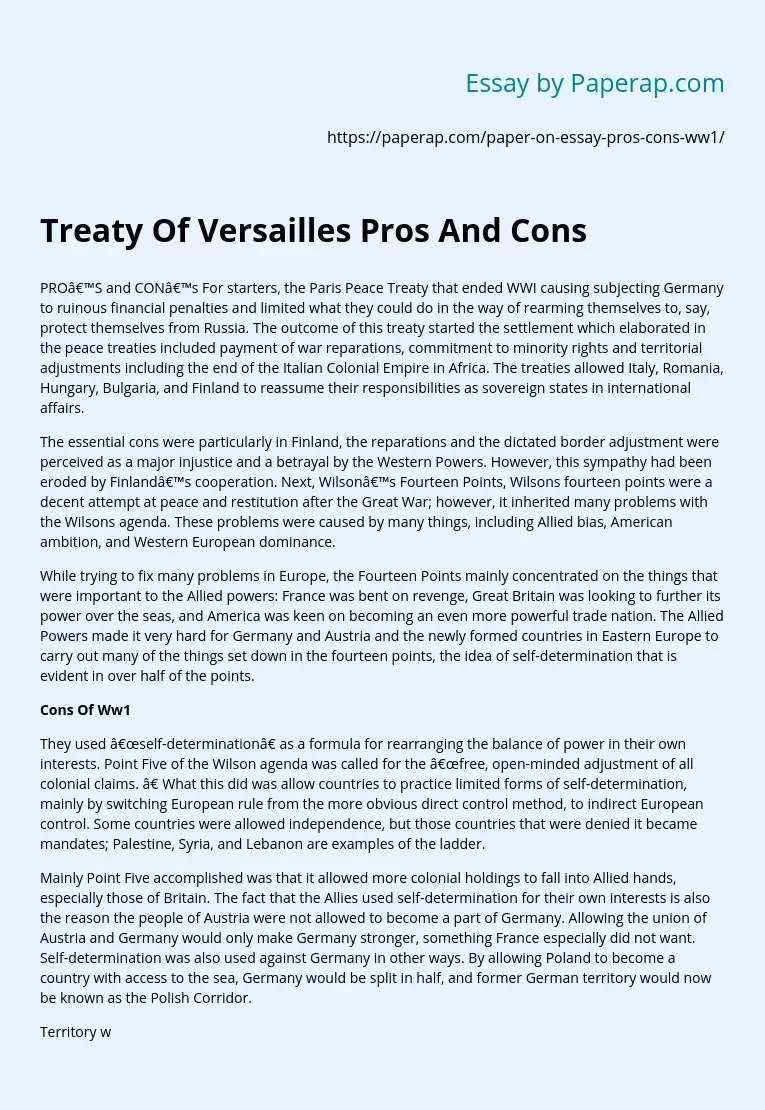Treaty Of Versailles Pros And Cons
PRO’S and CON’s For starters, the Paris Peace Treaty that ended WWI causing subjecting Germany to ruinous financial penalties and limited what they could do in the way of rearming themselves to, say, protect themselves from Russia. The outcome of this treaty started the settlement which elaborated in the peace treaties included payment of war reparations, commitment to minority rights and territorial adjustments including the end of the Italian Colonial Empire in Africa. The treaties allowed Italy, Romania, Hungary, Bulgaria, and Finland to reassume their responsibilities as sovereign states in international affairs.
The essential cons were particularly in Finland, the reparations and the dictated border adjustment were perceived as a major injustice and a betrayal by the Western Powers. However, this sympathy had been eroded by Finland’s cooperation. Next, Wilson’s Fourteen Points, Wilsons fourteen points were a decent attempt at peace and restitution after the Great War; however, it inherited many problems with the Wilsons agenda. These problems were caused by many things, including Allied bias, American ambition, and Western European dominance.
While trying to fix many problems in Europe, the Fourteen Points mainly concentrated on the things that were important to the Allied powers: France was bent on revenge, Great Britain was looking to further its power over the seas, and America was keen on becoming an even more powerful trade nation. The Allied Powers made it very hard for Germany and Austria and the newly formed countries in Eastern Europe to carry out many of the things set down in the fourteen points, the idea of self-determination that is evident in over half of the points.
Cons Of Ww1
They used “self-determination” as a formula for rearranging the balance of power in their own interests. Point Five of the Wilson agenda was called for the “free, open-minded adjustment of all colonial claims. ” What this did was allow countries to practice limited forms of self-determination, mainly by switching European rule from the more obvious direct control method, to indirect European control. Some countries were allowed independence, but those countries that were denied it became mandates; Palestine, Syria, and Lebanon are examples of the ladder.
Mainly Point Five accomplished was that it allowed more colonial holdings to fall into Allied hands, especially those of Britain. The fact that the Allies used self-determination for their own interests is also the reason the people of Austria were not allowed to become a part of Germany. Allowing the union of Austria and Germany would only make Germany stronger, something France especially did not want. Self-determination was also used against Germany in other ways. By allowing Poland to become a country with access to the sea, Germany would be split in half, and former German territory would now be known as the Polish Corridor.
Territory was also taken away from Germany to create the nation of Lithuania. Following Leauge of Nations, The problem of bringing its political influence to bear, especially on the great powers, soon made itself felt. Poland refused to abide by the League decision in the Vilnius dispute, and the League was forced to stand by powerlessly in the face of the French occupation of the Ruhr and Italy’s occupation of Kerkira in 1923. Failure to take action over the Japanese invasion of Manchuria was a blow to the League’s prestige, especially when followed by Japan’s withdrawal from the League.
Another serious failure was the inability of the League to stop the Chaco War between Bolivia and Paraguay. In 1935 the League completed its successful 15-year administration of the Saar territory under the supervision of an international military force. But even this success was not sufficient to offset the failure of the Disarmament Conference, Germany’s withdrawal from the League, and Italy’s successful attack on Ethiopia in defiance of the League’s economic sanctions. In 1936, Adolf Hitler remilitarized the Rhineland and denounced the Treaty of Versailles; in 1938 he seized Austria.
Faced by threats to international peace from all sides-the Spanish civil war, Japan’s resumption of war against China, and finally the appeasement of Hitler at Munich-the League collapsed Where the League commissioner had been reduced to impotence, led to the outbreak of World War II. The act of the League came in Dec. , 1939, when it expelled the USSR for its attack on Finland. In 1940 the League secretariat in Geneva was reduced to a skeleton staff; some of the technical services were removed to the United States and Canada.
The allied International Labor Organization continued to function and eventually became affiliated with the United Nations. In 1946 the League dissolved itself, and its services and real estate were transferred to the United Nations. The League’s chief success lay in providing the first pattern of permanent international organization, a pattern on which much of the United Nations was modeled. Its failures were due as much to the indifference of the great powers, which preferred to reserve important matters for their own decisions, as to weaknesses of organization. These are some of the successes and failures of the League of Nations.
One major failure was that it emerged out of the belief that all wars could be avoided if the moral force of world opinion was mobilized against it, but the League never represented world opinion because throughout its life it was only a League of Some Nations. As you can see, most programs and country’s ended in tragedy some ended in victory. Country’s lost while enemy’s gained. Proposals were made and war was ended. Great War caused useful formations and Radical changes were made for the best and for the worst. Point Five of Wilsons fourteen points accomplished was that it allowed more colonial holdings to fall into the allied hands.
Treaty Of Versailles Pros And Cons. (2019, Dec 05). Retrieved from https://paperap.com/paper-on-essay-pros-cons-ww1/

